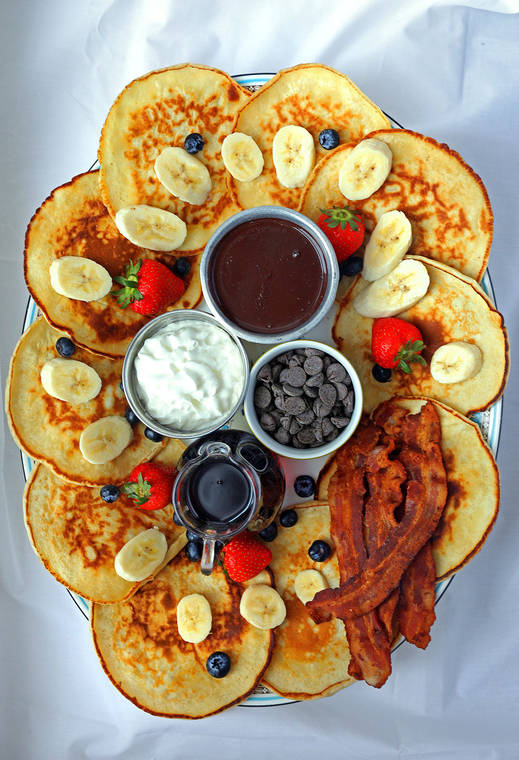I may have this wrong, but as far as I can tell, “charcuterie” is French for “a big plate full of stuff.”
Charcuteries are one of the biggest trends in the food world right now; you will find them on an ever-increasing number of restaurant menus, and small companies are popping up to bring them to you. Everyone likes them, and why not? They are big plates full of stuff.
Like so many other culinary notions, the idea of what a charcuterie is has evolved and expanded over the years, especially recently. But the original definition is still relevant: it is meat, often pork, prepared in a number of specific ways — smoked, cured, patés, terrines, sausages, confit and a couple of deboned methods.
A charcuterie board, which is what most people (and restaurants) mean when they say “charcuterie,” is a platter offering several of these meats and preparations.
But that isn’t nearly as fun as the current definition of the term. These days, the platter also includes a variety of well-chosen accompaniments. Cheeses, breads or crackers and a selection of complementary condiments such as preserves, pickled vegetables and more, are now considered necessary additions to any self-respecting charcuterie board.
And with the charcuterie concept now so open and free, there is no reason to stop at meats. These days, the only limit to a charcuterie board is your imagination.
I recently made three charcuteries: the traditional meat-and-cheese charcuterie, and, because I don’t like bloody Marys but do like martinis, a martini charcuterie.
Meat and cheese board
For the meat and cheese platter, I wanted to emphasize contrast — flavors, textures and even colors. The prettier the plate, the more your guests will appreciate it.
For the meat part of the platter, I rolled up a selection of Italian cold cuts: Calabrese salame, capocollo, sopressata and pepperoni, plus some sliced chicken breast for people who don’t like pork. I also wrapped prosciutto around chilled spears of asparagus, which is the best possible application for prosciutto.
I added cubes and wedges of fontina cheese and cubes of sharp cheddar; nothing too fancy to overwhelm the meat, which I think should be the star of the platter. Mini-breadsticks and crackers provided a backbone for the meats and cheese, with grainy mustard to add bite and cherry jam to soothe the tongue with its sweetness.
Roasted red peppers are a natural with any selection of sliced meat, and so are piquant gherkins, so onto my plate they went. Olives are good in pretty much any circumstance, and dried apricots are now traditional with meat and cheese charcuteries.
Nuts are essential. I used pistachios in their shell (because it is so much fun taking them out of their shells), almonds and sweet, glazed pecans. I had never bought glazed pecans before. Those things are amazing. I’m sure they would be easy to make yourself, but I took the easy route because I had two more charcuterie boards to prepare.
Martini board
My martini charcuterie started off with an assortment of gins and dry vermouths; my guests could mix and match to determine their favorite combination of straightforward crisp and dry gin, botanical gin or citrus-forward gin with floral vermouth or earthy and slightly bitter vermouth.
For the snack part of the charcuterie, I made two dishes that go with martinis like vermouth goes with gin.
Shrimp cocktail is an absolute classic; if you ask me, every bottle of gin ought to come with a little package of shrimp and the ingredients for cocktail sauce. And just as good as shrimp cocktail are deviled eggs, which pair perfectly with martinis and pretty much everything else.
Naturally, I laid out olives (for martinis) and pickled pearl onions (for Gibsons, which are similar to martinis but made with a pickled pearl onion instead of an olive). For an irresistible bit of crunchy sweetness, I brought out chocolate-covered almonds. Pretzels are appropriate with any cocktail, and so is a bar mix of peanuts, sesame sticks and other goodies.
Deviled Eggs
Yield: 8 servings
4 eggs
3 tablespoons mayonnaise
½ teaspoon Dijon mustard
½ teaspoon lemon juice
Salt and pepper
Paprika, optional
Fill a medium bowl halfway with ice and water, and set aside. Bring 1 inch of water or more to a boil in a pot that can fit a steamer. When it boils, place the eggs in the steamer in the pot, cover and steam for 12 to 13 minutes. Remove the eggs and immediately plunge into the ice water. When they are cool, they can be peeled and used immediately or kept in the shell in the refrigerator for several days.
Slice the eggs in half lengthwise and scoop out the yolks into a small bowl. Add mayonnaise, mustard, lemon juice and a pinch of salt and pepper; mix with a fork until smooth. Return mixture to egg whites. Serve with a sprinkle of paprika, for color, if desired.
Cocktail Sauce
Yield: 6 servings
1/2 cup chili sauce
1/3 cup ketchup
1 or 2 tablespoons prepared horseradish
1 1/2 teaspoons Worcestershire sauce
Juice from 1 wedge of lemon
Mix together all of the ingredients. Serve chilled with 1 pound cooked, chilled shrimp.



